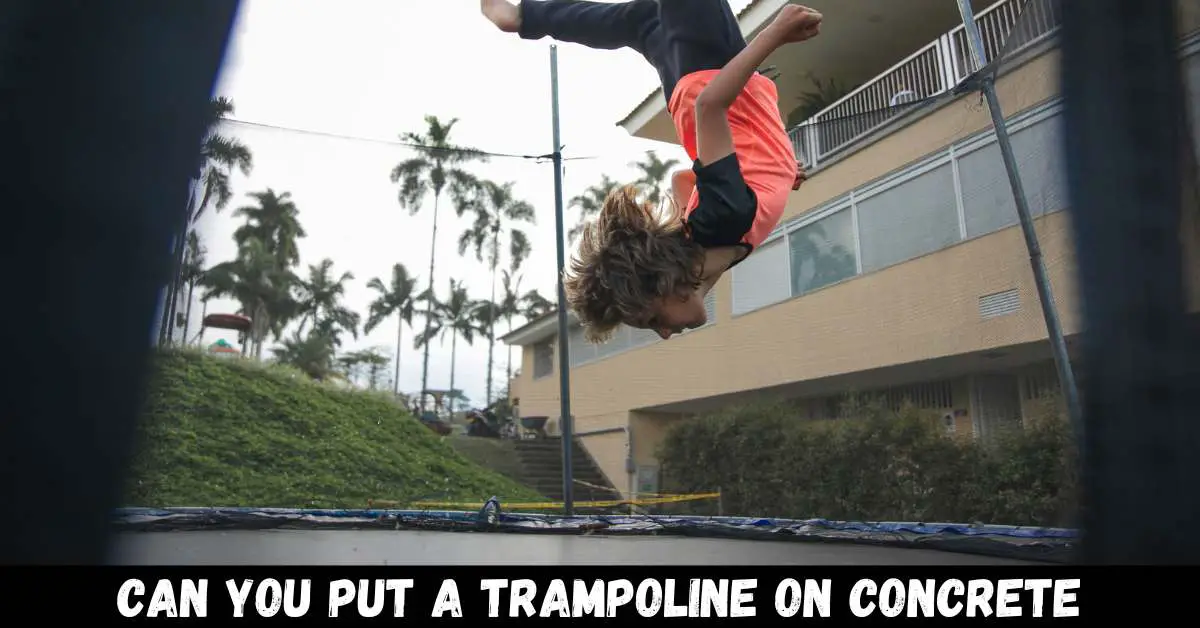Trampolines have become increasingly popular for outdoor entertainment and physical activity. They offer a thrilling way to bounce, jump, and perform acrobatic maneuvers, providing hours of enjoyment for both children and adults.
However, when it comes to installing a trampoline, the choice of the surface on which it will be placed is a critical consideration.
Concrete is a commonly available surface found in many residential settings. Its solid and level characteristics might make you wonder whether it is suitable for placing a trampoline. This question arises due to concerns about safety, stability, and the potential impact on the trampoline’s performance.
This article will explore the possibilities and challenges of placing a trampoline on concrete. We will delve into the advantages and drawbacks of this setup, discussing important factors such as safety precautions, potential risks, and alternative solutions.
By examining these aspects, you will understand whether a trampoline on concrete is a viable option for your specific circumstances.
Join us as we dive into the topic of trampolines and concrete surfaces, aiming to provide valuable insights and guidance to help you make an informed decision about the placement of your trampoline.
Can you put a trampoline on concrete? Yes, you can place a trampoline on concrete, but it’s essential to have proper safety measures in place, such as using safety padding or a safety net to prevent injuries.f injuries.
The Best Surface for Trampoline Installation
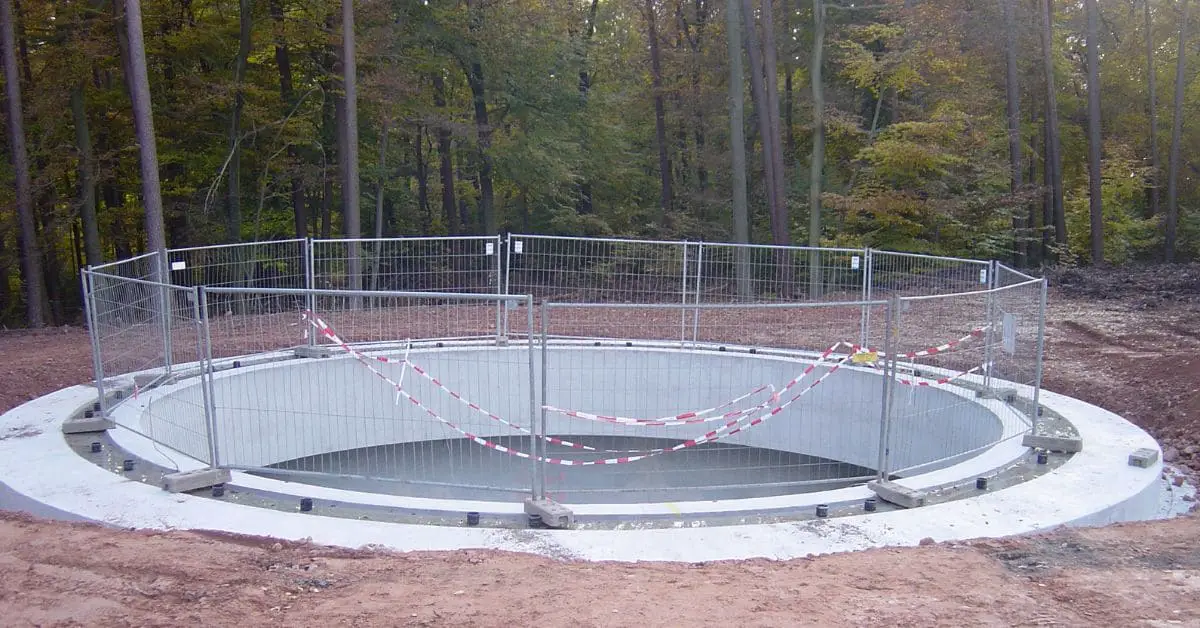
When it comes to installing a trampoline, choosing the right surface is crucial for safety and performance. Let’s explore different surface options and evaluate their suitability for trampolines, focusing on concrete, grass, and other alternatives.
Concrete:
Concrete is a solid and stable surface that provides excellent support for trampolines. It offers a level and even base, which ensures consistent bouncing and reduces the risk of the trampoline shifting or sinking.
However, concrete surfaces are generally considered less safe than other options due to their lack of shock absorption. If someone falls while jumping, the impact on concrete can be more jarring and increase the risk of injury.
Grass:
Grass is a popular surface choice for trampolines due to its natural cushioning effect. The softness of the grass helps absorb shocks, reducing the impact on joints and minimizing the risk of injury.
However, there are a few considerations to keep in mind. First, the ground should be relatively level to ensure the trampoline is stable.
Additionally, grass can wear down over time, particularly in high-traffic areas, leading to an uneven surface. Regular maintenance, such as reseeding or adding a protective mat under the trampoline, can help mitigate this issue.
Other Surfaces:
Sand:
Sand provides good shock absorption and is often used for professional trampoline installations. It cushions landings well and reduces the risk of injuries. However, sand can be challenging to maintain as it may shift and require periodic leveling.
Wood chips or mulch:
These materials offer decent shock absorption and can be a cost-effective option. However, they require regular maintenance to prevent them from compacting or scattering.
Rubber or foam pads:
These surfaces are specifically designed for trampolines and offer excellent shock absorption. They provide a cushioned landing area and minimize the risk of injuries. However, they can be relatively expensive and may require professional installation.
In terms of safety, grass, and surfaces specifically designed for trampolines, such as rubber or foam pads, are generally considered safer due to their shock-absorbing properties.
Concrete, while stable, poses a higher risk of injury due to its lack of cushioning. However, concrete can still be viable with proper precautions like adding safety pads and ensuring the trampoline is securely anchored.
Ultimately, the choice of surface depends on factors such as personal preference, budget, maintenance requirements, and the level of safety and performance desired.
It’s important to carefully evaluate the pros and cons of each surface option and consider the specific needs and circumstances of your trampoline installation.
Can You Put a Trampoline on Concrete?
Yes, it is possible to place a trampoline on a concrete surface. However, there are certain factors to consider before making this decision. While concrete is a solid and stable surface, there are advantages and challenges associated with placing a trampoline on it.
Advantages of Placing a Trampoline on Concrete

Placing a trampoline on concrete does have some advantages. Here are a few:
Stability: Concrete provides a stable base for the trampoline, reducing the risk of the trampoline shifting or moving during use.
Durability: Concrete is a durable surface that can withstand the trampoline’s weight and has regular use over time.
Maintenance: Unlike natural surfaces like grass, concrete requires minimal maintenance and does not need mowing, watering, or trimming.
Challenges of Placing a Trampoline on Concrete:
Safety Concerns: Concrete is a hard surface with little to no shock absorption. This can increase the risk of injuries if someone falls or jumps off the trampoline. Safety precautions, such as installing safety padding around the trampoline or using safety nets, are crucial to minimize the risk of injuries.
Impact on Bounce: Concrete has a low level of shock absorption, which can affect the bounce quality of the trampoline. The lack of a forgiving surface may reduce the trampoline’s rebound effect and overall performance.
Noise and Vibration: Trampolines on concrete tend to produce more noise and vibrations compared to other surfaces. This can be bothersome for neighbors or residents in the vicinity.
Expert opinions on placing a trampoline on concrete:
Trampoline manufacturers and safety experts generally discourage placing trampolines on hard surfaces like concrete due to the increased risk of injuries. The American Academy of Pediatrics (AAP) recommends placing trampolines on a soft, impact-absorbing surface such as grass, wood chips, or safety-rated impact mats.
If you decide to install a trampoline on concrete, taking additional safety measures to mitigate the risks is essential. Ensure the trampoline is securely anchored to the ground, use safety padding and nets, and regularly inspect the trampoline for any signs of wear or damage.
Ultimately, while placing a trampoline on concrete is feasible, it is important to prioritize safety and consider alternative surfaces that provide better shock absorption and reduce the risk of injuries.
Soft Rubber Base for Trampoline on Concrete
If you have decided to place your trampoline on a concrete surface, a soft rubber base can improve safety and shock absorption. A soft rubber base provides a cushioning effect and helps reduce the impact on joints and bones when jumping on the trampoline.
Here’s a look at the benefits of using a soft rubber base and some reliable products available:
Benefits of Using a Soft Rubber Base:
Shock Absorption: Soft rubber bases absorb more impact than concrete, providing trampoline users a safer and more forgiving surface. This can help reduce the risk of injuries, particularly to joints and bones.
Improved Bounce Quality: A soft rubber base can enhance the bounce quality of the trampoline by adding an extra layer of cushioning. It allows for a more enjoyable and responsive jumping experience.
Noise Reduction: Placing a soft rubber base under the trampoline can help dampen the noise and vibrations that typically occur when the trampoline is on a hard surface like concrete. This can be beneficial if you have neighbors or live in a shared space.
Reliable Soft Rubber Base Products:
Trampolines with Built-in Rubber Pads: Some trampolines come with built-in rubber pads or feet that provide a layer of cushioning between the trampoline frame and the ground. These pads are specifically designed to enhance shock absorption and improve safety on hard surfaces.
Rubber Matting or Tiles: You can purchase rubber matting or interlocking rubber tiles that are designed for outdoor use. These can be placed under the trampoline to create a soft, impact-absorbing surface.
Look for products that have sufficient thickness and durability to withstand the weight and impact of the trampoline.
Impact-Absorbing Underlay: Another option is to use an impact-absorbing underlay specifically designed for trampolines. These underlays are made from foam or rubber and placed beneath the trampoline to provide a soft and cushioned surface.
When selecting a soft rubber base for your trampoline, it is important to ensure that the product is durable for outdoor use and provides adequate shock absorption.
Additionally, follow the manufacturer’s recommendations for installation and maintenance.
Remember, even with a soft rubber base, it is crucial to implement other safety measures, such as safety padding and nets to further reduce the risk of injuries. Regularly inspect the trampoline and the soft rubber base for any signs of wear or damage and replace them as needed.
By using a soft rubber base, you can significantly improve the safety and comfort of your trampoline on a concrete surface, providing a better jumping experience for users of all ages.
Securing a Trampoline on Concrete: Ensuring Safety and Stability
When placing a trampoline on a concrete surface, it is crucial to properly secure it to ensure the safety of users and maintain stability during use. Proper anchoring helps prevent the trampoline from shifting, tipping over, or moving excessively, reducing the risk of accidents and injuries.
we will provide step-by-step instructions on how to effectively secure a trampoline on concrete.
Importance of Properly Securing a Trampoline on Concrete:
Stability: Concrete surfaces are generally harder and less forgiving than softer surfaces like grass or soil. The trampoline can shift or move during use without proper anchoring, compromising stability and potentially leading to accidents.
Safety: An unsecured trampoline on concrete increases the risk of injuries. Users may be more prone to falling off or experiencing uncontrolled movements due to the lack of shock absorption provided by the surface.
Properly securing the trampoline helps minimize these risks and ensures a safer jumping experience.
Protection Against Wind: Wind gusts can pose a significant risk to trampolines, especially when placed on concrete surfaces. Proper anchoring provides stability and helps prevent the trampoline from being blown over during strong winds, reducing the risk of damage or accidents.
Step-by-Step Guide to Anchoring a Trampoline on Concrete:

Before you begin, gather the necessary tools and equipment:
- The trampoline anchor kit typically includes sturdy straps, ground anchors, and any additional hardware required for installation.
- Drill or impact driver: To create holes in the concrete for anchor placement.
- Masonry bit: A specialized drill bit designed for drilling into concrete.
- Measuring tape: To ensure accurate placement of the anchors.
- Hammer or mallet: To secure the anchors into the concrete.
- Wrench or socket set: To tighten the straps and any other hardware included in the anchor kit.
Follow these step-by-step instructions to effectively anchor your trampoline on concrete:
Step 1: Prepare the Trampoline:
Make sure your trampoline is fully assembled and positioned on the desired spot on the concrete surface. Ensure there is enough space around the trampoline for safe and unobstructed use.
Step 2: Determine Anchor Placement:
Refer to the manufacturer’s instructions or anchor kit guidelines to determine your trampoline model’s recommended anchor placement. Measure and mark the locations where the anchors will be installed. Typically, you’ll need to install one anchor at each leg of the trampoline.
Step 3: Drill Holes in the Concrete:
Using a masonry bit appropriate for your anchor size, drill holes into the marked locations on the concrete surface. The depth of the holes should be according to the anchor kit instructions, typically around 2-3 inches deep. Ensure the holes are straight and clean.
Step 4: Insert the Anchors:
Insert the ground anchors into the drilled holes, making sure they are securely seated. Use a hammer or mallet to tap them gently if needed. Ensure the anchors are flush with the surface of the concrete.
Step 5: Attach Straps to the Trampoline Legs:
Attach the straps provided in the anchor kit to the designated anchor points on the trampoline legs. These anchor points are usually located near the bottom of the leg frame. Follow the manufacturer’s instructions for proper attachment.
Step 6: Secure the Straps to the Anchors:
Thread the loose end of each strap through the corresponding ground anchor. Pull the strap tight, removing any slack, but avoid over-tightening, as it may strain the trampoline frame. Repeat this process for all trampoline legs.
Step 7: Tighten and Adjust:
Tighten the strap connections between the trampoline legs and the ground anchors using a wrench or socket set.
Step 8: Double-Check and Test:
After securing all the straps, double-check that they are tight and the trampoline is stable. Gently shake the trampoline to ensure it does not move or wobble excessively. If you notice any instability or looseness, adjust the straps accordingly and retighten them.
Step 9: Regular Inspections:
Regularly inspect the trampoline’s anchor points, straps, and overall condition. Check for any signs of wear, damage, or loosening. If any issues are detected, promptly address them by replacing damaged parts or readjusting the anchor system.
Step 10: Consider Additional Safety Measures:
While anchoring the trampoline is essential, it is also recommended to implement additional safety measures. Install safety padding around the trampoline’s frame and springs to provide cushioning and protect users from impact.
Consider using a safety net enclosure to prevent accidental falls off the trampoline.
Remember, proper installation and maintenance are vital for the ongoing safety and stability of the trampoline on concrete. It is also essential to follow the specific guidelines provided by the trampoline and anchor kit manufacturers.
Safety Measures to Enhance Trampoline Safety on Concrete
While properly securing a trampoline on concrete is crucial, there are additional safety measures you can implement to further enhance the safety of trampoline use. These measures protect against accidents and injuries, particularly when using a trampoline on a hard surface.
Here are some recommended safety measures to consider:
Safety Nets:
Installing a safety net enclosure around the trampoline is highly recommended. Safety nets act as a physical barrier, preventing users from accidentally falling off the trampoline onto the concrete surface.
They are designed with high-quality netting and sturdy poles to provide a secure, enclosed jumping area. Safety nets effectively reduce the risk of falls and can significantly enhance trampoline safety.
Crash Mats or Impact-Absorbing Underlays:
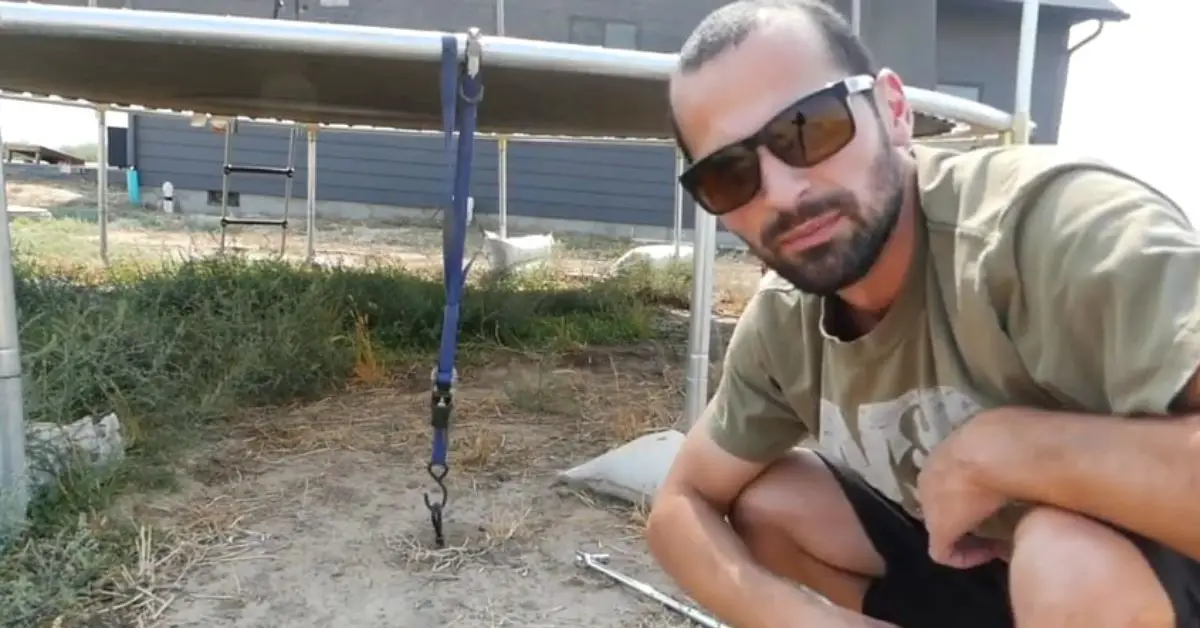
Placing crash mats or impact-absorbing underlays beneath and around the trampoline adds an extra cushioning layer.
These mats are specifically designed to absorb the impact of falls, providing a softer landing surface.
They are typically made from foam or rubber materials that offer shock absorption and reduce the risk of injuries.
Crash mats are particularly beneficial when using a trampoline on a hard surface like concrete, as they provide additional protection against hard landings.
Safety Padding:
Safety padding is an essential safety feature for any trampoline, regardless of the surface it’s placed on. Thick and durable padding covers the trampoline’s frame, springs, and other hard components, reducing the risk of impact injuries.
Safety padding helps protect users from accidental collisions with the trampoline’s metal frame and springs. It is crucial to regularly inspect the padding for signs of wear or damage and promptly replace any worn-out or torn sections.
Regular Inspections:
Regular inspections of the trampoline and its safety components are vital for maintaining a safe jumping environment. Check the frame, springs, safety nets, safety padding, and any anchor system for any signs of wear, damage, or loose connections.
Pay attention to the condition of the trampoline mat, ensuring there are no tears or excessive stretching. Regular maintenance and prompt repairs or replacements will help keep the trampoline in optimal and safe condition.
Safe Jumping Practices and Supervision:
Educate users, especially children, on safe jumping practices and proper trampoline etiquette. Encourage one person to jump at a time and discourage risky behaviors like somersaults or flips unless performed under expert supervision.
Adult supervision is important to ensure safe and responsible trampoline use, particularly for younger children.
Establish Safety Rules and Boundaries:
Set clear safety rules and boundaries for trampoline use. Establish guidelines regarding the number of users, proper jumping techniques, and any prohibited activities. Emphasize the importance of following these rules to prevent accidents and injuries.
Remember, trampoline safety is a shared responsibility. Educating all users, supervising trampoline activities, and implementing multiple layers of safety measures to maximize protection are essential.
By combining proper trampoline installation, regular maintenance, and additional safety features like safety nets, crash mats, and safety padding, you can significantly enhance the safety of trampoline use, even on a concrete surface.
Products for Trampolines on Concrete
If you have a trampoline placed on a concrete surface, using high-quality rubber mats or flooring can provide additional safety, shock absorption, and protection. Here are some recommended products suitable for trampolines on concrete, along with their features:
ProSource Puzzle Exercise Mat
Features: This puzzle exercise mat is made from high-density EVA foam, which offers excellent shock absorption and cushioning. The interlocking tiles allow for easy installation and customization to fit the size of your trampoline. The mat is water-resistant, easy to clean, and provides a non-slip surface.
Benefits: The ProSource Puzzle Exercise Mat provides a comfortable, impact-absorbing surface that reduces strain on joints and bones. Its durability and versatility make it a popular choice for trampoline use on concrete.
IncStores Outdoor Sports Tile
Features: The Outdoor Sports Tile by IncStores is a modular flooring option designed for outdoor use. The tiles are made from durable polypropylene plastic and have a perforated surface for excellent water drainage. They interlock securely and are resistant to UV rays and harsh weather conditions.
Benefits: These tiles offer superior traction, impact resistance, and shock absorption. The perforated design allows rainwater to drain through, keeping the surface dry and safe. The durable construction ensures long-lasting performance, even under heavy use.
Rubber-Cal “Tuff-N-Lastic” Rubber Flooring Rolls

Features: “Tuff-N-Lastic” rubber flooring rolls are made from SBR rubber, providing excellent durability, shock absorption, and sound insulation.
The rolls are available in various thicknesses and lengths, allowing for customization to fit your trampoline size.
The textured surface enhances traction and slip resistance.
Benefits: The Rubber-Cal “Tuff-N-Lastic” flooring rolls offer exceptional impact resistance and cushioning, making them an ideal choice for trampoline use on concrete. The rolls provide a seamless and continuous surface, reducing the risk of tripping or slipping.
Gorilla Mats Extra Large Exercise Mat
Features: The Gorilla Mats Extra Large Exercise Mat is made from high-density, non-toxic rubber material. It is thick and durable, providing excellent shock absorption and cushioning. The mat has a non-slip surface texture and is easy to clean and maintain.
Benefits: This extra-large exercise mat offers ample space and protection around the trampoline. It helps reduce the impact on joints and provides a stable surface for safe trampoline use. The non-slip texture ensures a secure footing during jumps and movements.
Rubber Flooring Inc. Eco-Sport Interlocking Rubber Tile
Features: The Eco-Sport Interlocking Rubber Tile is made from recycled rubber and features interlocking edges for easy installation. The tiles are available in various thicknesses and offer excellent impact resistance, shock absorption, and slip resistance. They are resistant to water, mold, and mildew.
Benefits: These rubber tiles provide a cushioned and durable surface for trampoline use on concrete. The recycled rubber material is eco-friendly, and the interlocking design ensures a secure and stable surface. The tiles are low-maintenance and suitable for both indoor and outdoor use.
When selecting a rubber mat or flooring for your trampoline, consider factors such as thickness, shock absorption capabilities, durability, and ease of installation.
Additionally, ensure that the product is suitable for outdoor use and can withstand the weight and impact of trampoline activities.
Remember to follow the manufacturer’s instructions for installing and maintaining the chosen product. Regularly inspect the mats or flooring for any signs of wear or damage, and replace them as needed to maintain optimal safety and performance for your trampoline on concrete.
Safety Clearance and Jumping Space
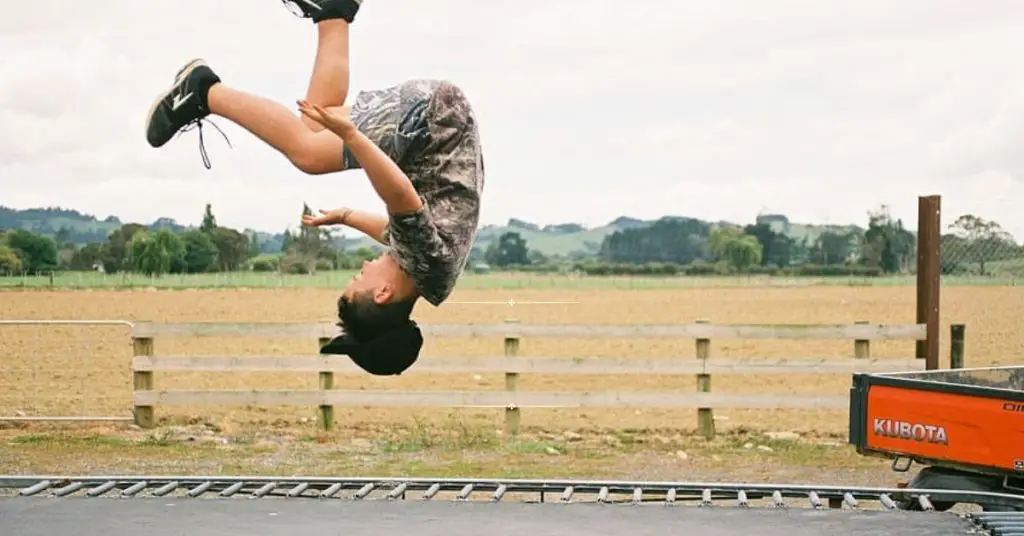
When installing a trampoline, it is essential to consider the space required around it for safety reasons.
Adequate clearance around the trampoline and above the jumping area is crucial to ensure a safe and enjoyable trampoline experience.
we will discuss the space considerations for trampoline installation, including the necessary clearance around the trampoline and the recommended height clearance above the trampoline.
Clearance Around the Trampoline:
Horizontal Clearance:
To ensure safety during trampoline use, a clear area around the trampoline is recommended to be free from obstructions. The horizontal clearance should be a minimum of 3-6 feet (1-2 meters) on all sides.
This provides enough space for users to safely enter and exit the trampoline and reduces the risk of colliding with nearby objects or structures.
Vertical Clearance:
Consider the vertical clearance when placing the trampoline. Ensure no overhanging objects, such as tree branches, power lines, or awnings, are directly above the trampoline.
The recommended vertical clearance above the trampoline is at least 20 feet (6 meters) to provide sufficient airspace for safe jumping.
This clearance helps prevent users from accidentally hitting or getting caught on objects above the trampoline while jumping.
It is essential to carefully evaluate the surrounding area and make sure there are no potential hazards or obstacles that could pose a risk to trampoline users.
Regularly inspect the clearance area, trim any overhanging branches, or remove any objects that may infringe upon the recommended clearances.
Safe Jumping Space:
Apart from the clearance around the trampoline, the jumping area itself must also have enough space to ensure safe and unrestricted movement. The size of the jumping mat varies depending on the trampoline’s diameter or dimensions.
However, it is generally recommended to have a minimum of 2 feet (0.6 meters) of free space around the perimeter of the jumping mat.
The free space around the jumping mat is important for several reasons:
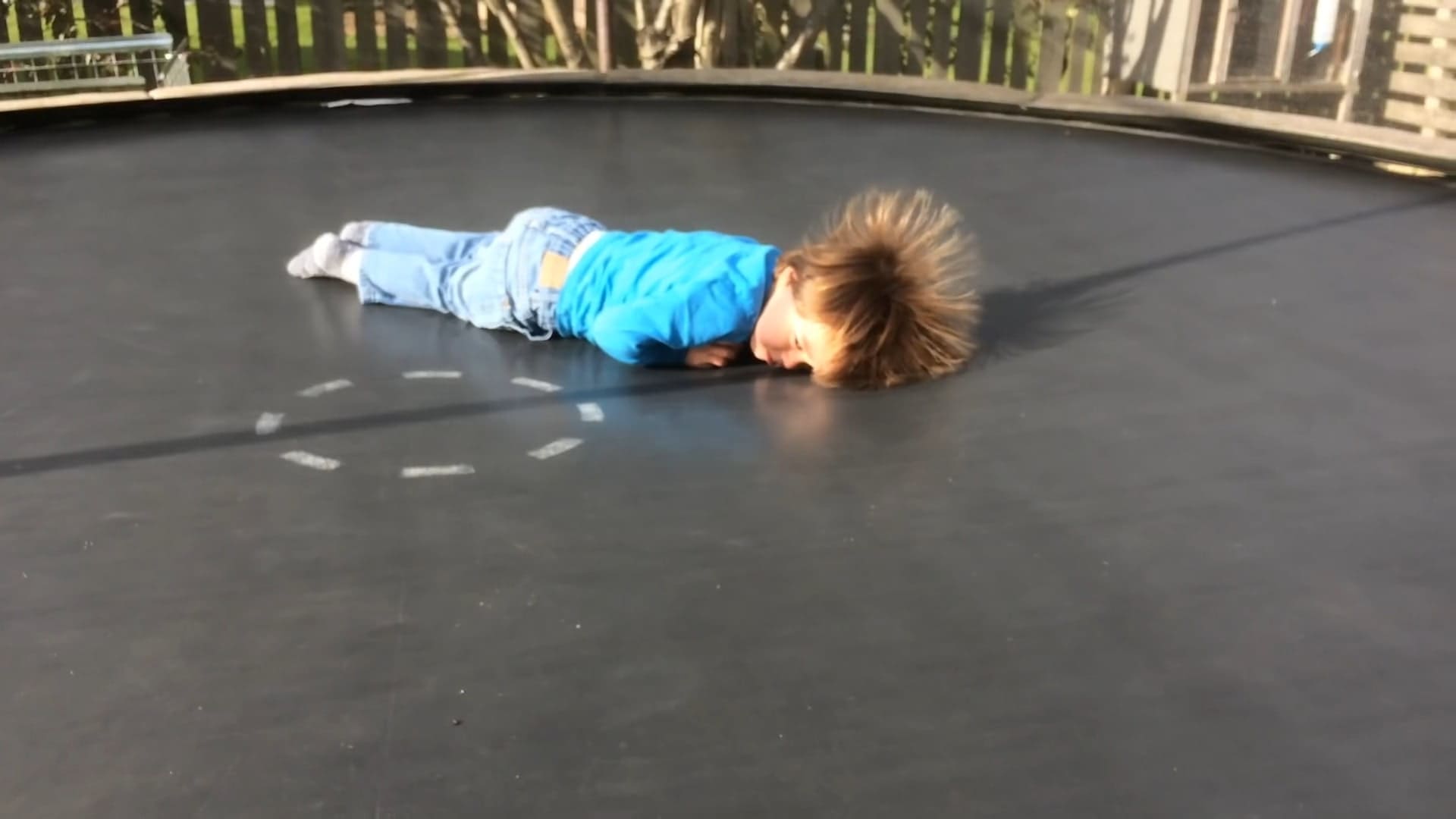
Safety during Falls: Users may occasionally lose balance or accidentally jump off the mat.
The free space around the trampoline allows for a safe landing zone, reducing the risk of collisions with surrounding objects or the ground.
Preventing Bounces off the Mat: Having sufficient space around the mat helps prevent users from bouncing off the trampoline onto the ground or nearby structures. It ensures that the jumping remains contained within the trampoline’s boundaries.
Avoiding Collisions: The free space around the mat provides room for multiple users to jump without colliding with each other. It allows for safer group jumping and reduces the risk of accidents caused by collisions.
Ensuring adequate clearance around the trampoline and sufficient free space on the jumping mat can create a safer environment for trampoline use. Always follow the manufacturer’s guidelines regarding space requirements and consult local regulations or guidelines specific to your area.
Remember, maintaining a safe and hazard-free environment around the trampoline is crucial for preventing accidents and injuries. Regularly inspect the area, keep the surroundings clean, and educate users on safe jumping practices to maximize trampoline safety.
Lighting and Backyard Fit:
When considering the installation of a trampoline in your backyard, it is important to assess the lighting conditions and the suitability of the space. Good lighting and a properly fitting backyard are crucial factors in ensuring a safe and enjoyable trampoline experience.
we will emphasize the importance of good lighting in the trampoline area and provide tips for assessing whether your backyard can accommodate a trampoline.
Visibility and Safety:
Good lighting in the trampoline area is essential for maintaining visibility and ensuring the safety of trampoline users. Sufficient lighting allows users to clearly see the jumping mat, springs, and surrounding areas, minimizing the risk of tripping, colliding, or falling off the trampoline.
Adequate visibility is particularly crucial during evening or nighttime use.
Awareness of Surroundings:
Proper lighting enables trampoline users to be aware of their surroundings, including nearby obstacles, structures, or other nearby individuals. This awareness helps prevent accidents and ensures that users can safely navigate the trampoline area.
Supervision and Monitoring:
Good lighting for children using the trampoline allows parents or supervisors to monitor their activity more effectively. Observing their jumping techniques, adherence to safety guidelines, and overall well-being becomes easier, reducing the chances of accidents going unnoticed.
Tips for Assessing Your Backyard:
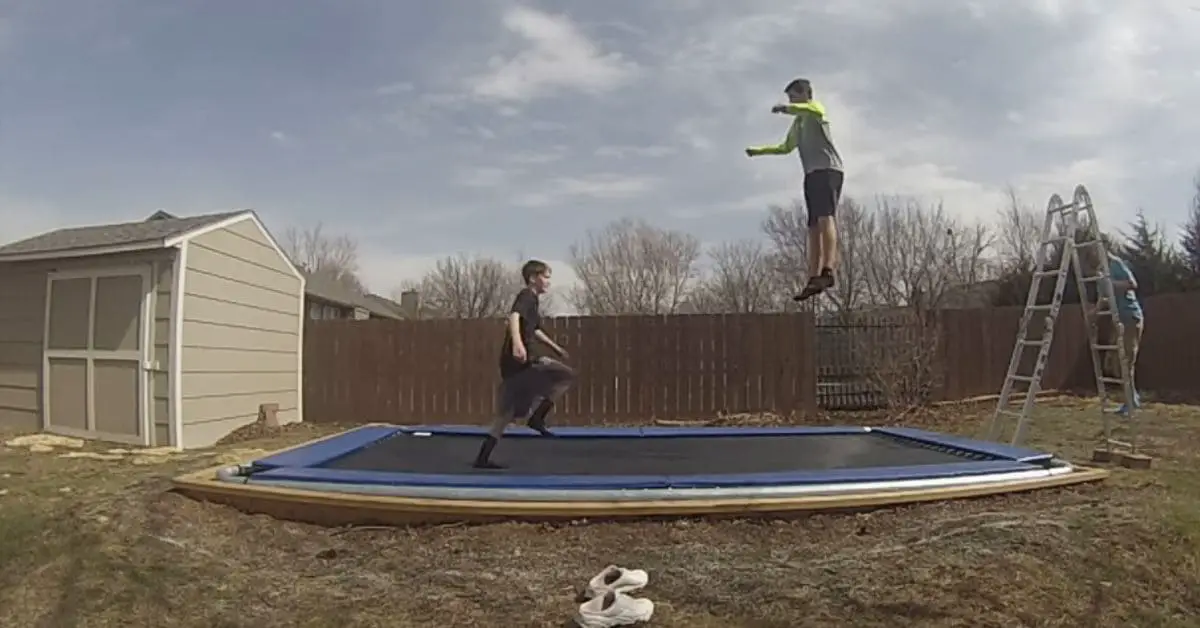
Assessing your backyard is essential in determining the suitability and optimal placement for a trampoline or any other outdoor equipment.
Here are some useful tips to help you thoroughly evaluate your backyard:
Available Space:
Evaluate the available space in your backyard to determine if it can accommodate a trampoline safely. Measure the dimensions of the trampoline you intend to install and ensure that you have adequate clearance around it, as discussed in the previous section.
Consider any other structures, landscaping features, or utility lines that may pose obstacles or safety concerns.
Level Ground:
Check if your backyard provides a level and stable surface for the trampoline. Avoid placing the trampoline on uneven or sloping ground, as this can affect its stability and increase the risk of tipping over.
If needed, prepare the ground by leveling it or using appropriate landscaping techniques to create a stable base.
Clearance from Obstacles:
Ensure that there is sufficient clearance from obstacles such as fences, trees, shrubs, or walls. The trampoline should be placed away from any objects that users may collide with during jumping. Also, consider the clearance discussed in the previous sections, both horizontally and vertically.
Sunlight Exposure:
Assess the sunlight exposure in the proposed trampoline area. While some sunlight is beneficial, excessive direct sunlight for prolonged periods can cause the trampoline’s materials to deteriorate faster.
Consider placing the trampoline in an area that balances sunlight and shade, or use a shade canopy or umbrella for protection.
Privacy and Noise Considerations:
Take into account privacy and noise considerations when selecting the trampoline location. Ensure that the trampoline is placed in an area that offers the desired level of privacy and minimizes noise disturbances to neighbors or nearby buildings.
By assessing the lighting conditions and evaluating your backyard’s suitability, you can create a safer and more enjoyable environment for trampoline use. Prioritize good lighting to enhance visibility and safety.
Consider the available space, level ground, clearance from obstacles, sunlight exposure, privacy, and noise considerations to determine the best location for your trampoline.
Remember to consult any local regulations or guidelines for trampoline installation in your area and follow the manufacturer’s instructions for proper installation and maintenance. Regularly inspect the trampoline and its surroundings to ensure ongoing safety and enjoyment.
Can you put a trampoline on the pavers?
No, putting a trampoline on concrete is not a good idea. Even though concrete seems like a solid surface, the impact of bouncing on it can actually harm your trampoline. The force can damage the frame and legs of the trampoline, so it’s best to avoid placing it directly on concrete.
FAQs
Q.1 Can you put a trampoline on slabs
No, putting a trampoline on concrete is not a good idea. Even though concrete seems like a solid surface, the impact of bouncing on it can actually harm your trampoline. The force can damage the frame and legs of the trampoline, so it’s best to avoid placing it directly on concrete.
Q.2 Is it safe to put a trampoline on concrete
It’s not a good idea to put a trampoline on concrete. It’s dangerous because concrete doesn’t absorb impact and could cause harm. The trampoline’s frame could get damaged, people jumping on it could get hurt, and it’s hard to secure the trampoline properly on concrete.
Q.3 What are some alternatives to placing a trampoline on concrete?
Instead of concrete, consider placing your trampoline on softer surfaces that provide cushioning, such as grass, sand, or bark. These surfaces can absorb impact and reduce the risk of injuries.
Q.4 Can I use a trampoline on concrete if I add a soft rubber base?
While a soft rubber base can provide some cushioning, it may not eliminate the risks of using a trampoline on concrete. It’s still recommended to choose a softer surface for better safety.
Q.5 Where should I put my trampoline?
Look for a safe and level spot to set up your trampoline. Ensure no obstacles are nearby, like fences, trees, or other equipment. Choose a soft surface that can absorb energy when you jump. Examples of good surfaces are sand, bark, or materials that provide a cushioning effect.
Conclusion
In conclusion, placing a trampoline directly on concrete is not recommended due to safety concerns and potential damage to the trampoline.
Soft surfaces like grass, sand, or bark are better alternatives. However, if you choose to install a trampoline on concrete, it is crucial to properly secure it for safety and stability.
A soft rubber base can provide some cushioning but may not eliminate all risks associated with concrete surfaces. Ensure the trampoline is securely anchored by following a step-by-step guide and regularly inspecting it for any signs of damage.
Additional safety measures, such as crash mats, safety padding, regular inspections, safe jumping practices, and supervision, can further enhance trampoline safety on concrete.
Several products, including exercise mats and rubber flooring, can be used as a protective layer between the trampoline and concrete.
Maintaining proper safety clearance and jumping space is essential. Consider horizontal and vertical clearance and the safe jumping space around the trampoline to prevent accidents and injuries.
It is important to assess your backyard for suitability and ensure good lighting, visibility, awareness of surroundings, and proper supervision.
By following these guidelines and considering safety precautions, you can make informed decisions about placing a trampoline on concrete and creating a safer environment for trampoline usage.
We hope this guide has given you a good understanding of whether you can put a trampoline on concrete. If you still have any questions, please feel free to leave a comment below!

